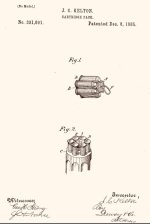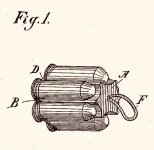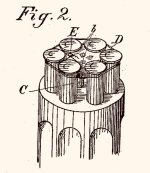I’ve been researching antique speed loaders for a few years. Mostly how they related to the early Police Departments.
Extremely difficult research since the early speed loaders called “CARTRIDGE PACKS” were made of wood and designed to be discarded or “dropped” after use.
The Smith & Wesson topbreak 45 Schofield was actually a test gun for an early speed loader patented by Brigadier General John C. Kelton on December 8, 1885 and then again with an improvement to the “wood” design on December 11, 1888. See photo’s.
He specifically documents Smith & Wesson revolvers in his patent description including Other revolvers. At that specific time in history this would have included any topbreaks and the Shattuck patented swing-out cylinder bulldogs. It’s also listed in the description to be designed to reload a revolver in 4 seconds.
Very interesting research.
Apparently the U.S. Army tested the device seen in photo’s 1&2 and manufactured 200 speed loaders (cartridge packs) for the test. The device was not adopted by the U.S. Army likely due to the rudimentary design but I am finding written evidence of the term “CARTRIDGE PACK” being issued as standard issue equipment to some police departments in the 1880’s.
Because the early “speed loader” was constructed of wood and specifically designed to be discarded after use it’s literally impossible to find one today from that early era. I’m convinced that they were carried and used often in the field so the research continues.
The early Bell patent of 1879 (last photo) Patented In the city of Baltimore of all places was likely used by the Baltimore Police to “speed load” the BABY RUSSIAN.
I’m convinced this is a huge part of why the Baby Russian remained in service for over 40 years. Simply because it could be rapidly reloaded.
I plan on eventually manufacturing a reproduction of the Bell “cartridge pack” of 1879 and testing it on the Baby Russian. It will be made primarily of wood with a matching design seen in the original patent drawing.
Murph
Extremely difficult research since the early speed loaders called “CARTRIDGE PACKS” were made of wood and designed to be discarded or “dropped” after use.
The Smith & Wesson topbreak 45 Schofield was actually a test gun for an early speed loader patented by Brigadier General John C. Kelton on December 8, 1885 and then again with an improvement to the “wood” design on December 11, 1888. See photo’s.
He specifically documents Smith & Wesson revolvers in his patent description including Other revolvers. At that specific time in history this would have included any topbreaks and the Shattuck patented swing-out cylinder bulldogs. It’s also listed in the description to be designed to reload a revolver in 4 seconds.
Very interesting research.
Apparently the U.S. Army tested the device seen in photo’s 1&2 and manufactured 200 speed loaders (cartridge packs) for the test. The device was not adopted by the U.S. Army likely due to the rudimentary design but I am finding written evidence of the term “CARTRIDGE PACK” being issued as standard issue equipment to some police departments in the 1880’s.
Because the early “speed loader” was constructed of wood and specifically designed to be discarded after use it’s literally impossible to find one today from that early era. I’m convinced that they were carried and used often in the field so the research continues.
The early Bell patent of 1879 (last photo) Patented In the city of Baltimore of all places was likely used by the Baltimore Police to “speed load” the BABY RUSSIAN.
I’m convinced this is a huge part of why the Baby Russian remained in service for over 40 years. Simply because it could be rapidly reloaded.
I plan on eventually manufacturing a reproduction of the Bell “cartridge pack” of 1879 and testing it on the Baby Russian. It will be made primarily of wood with a matching design seen in the original patent drawing.
Murph
Attachments
Last edited:





